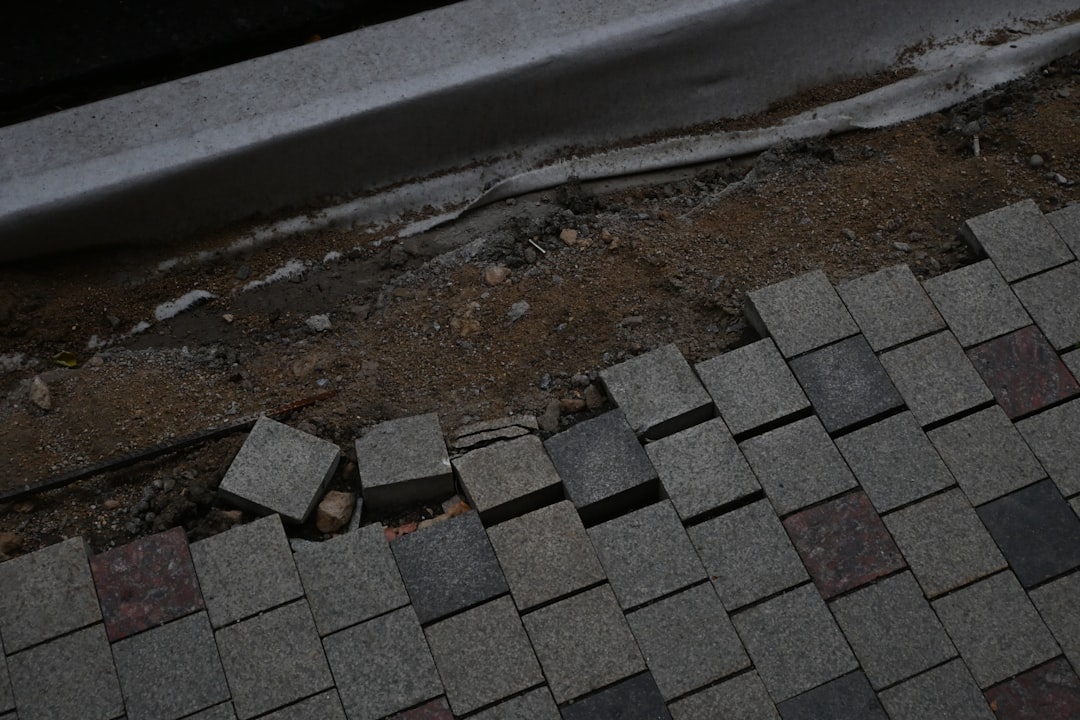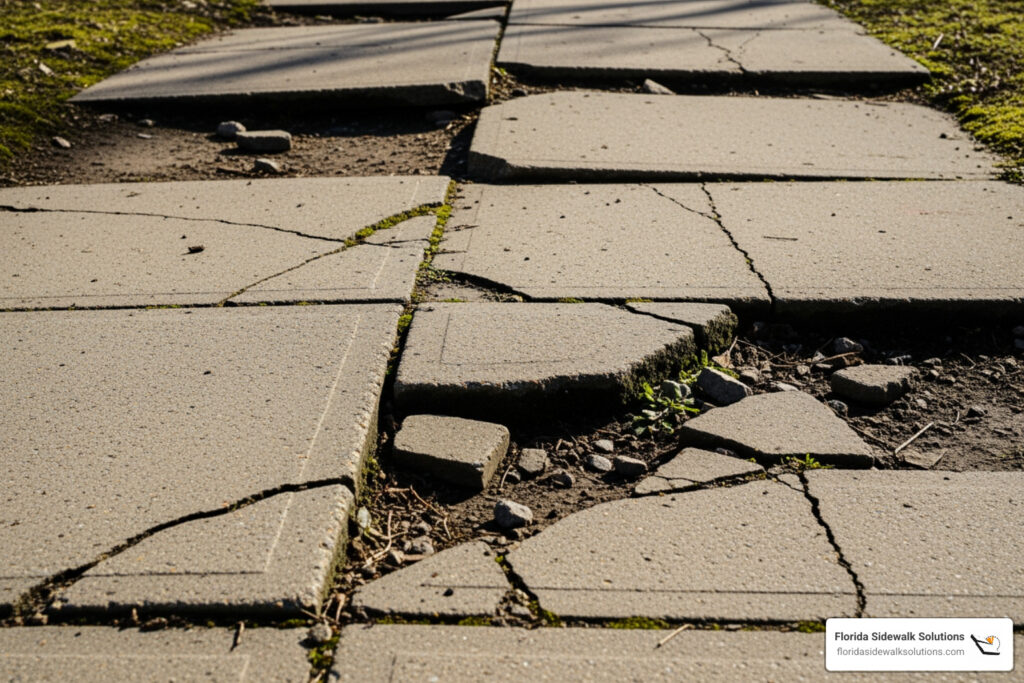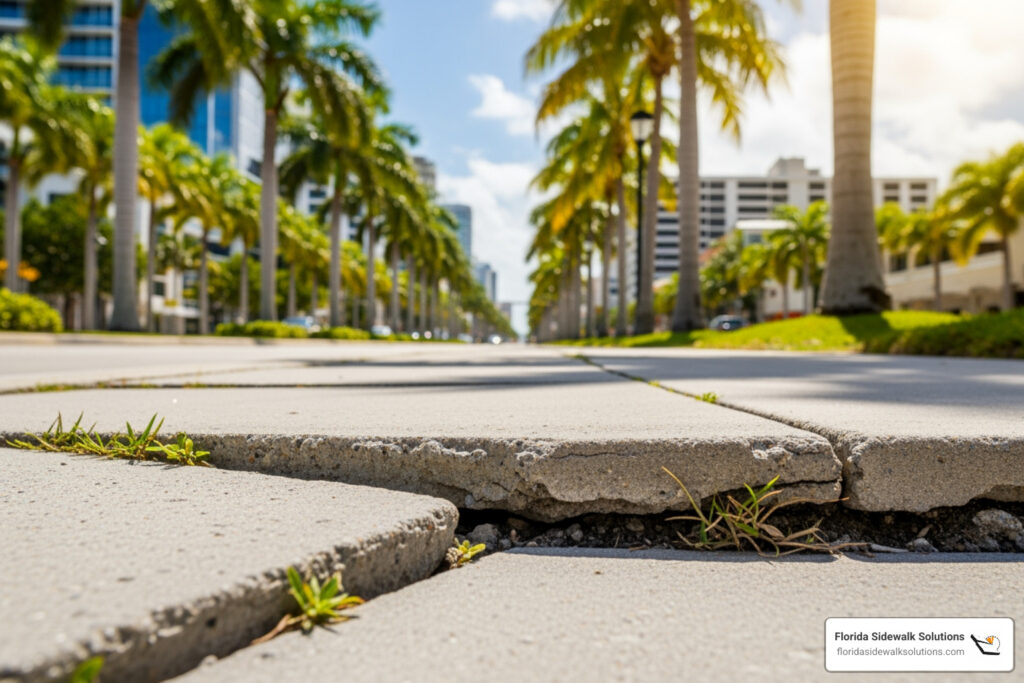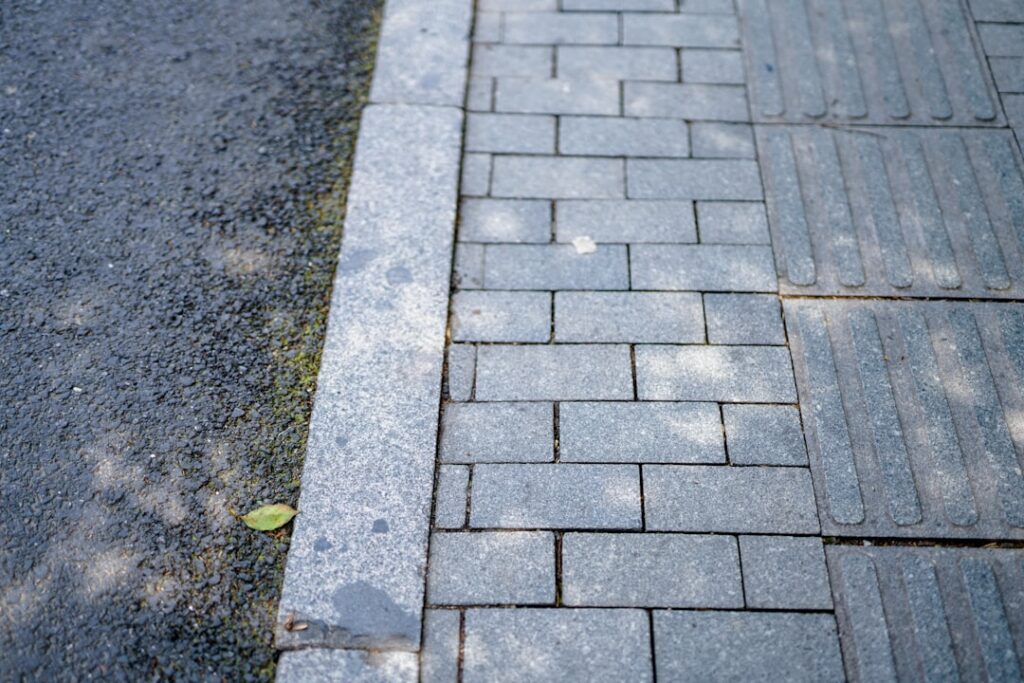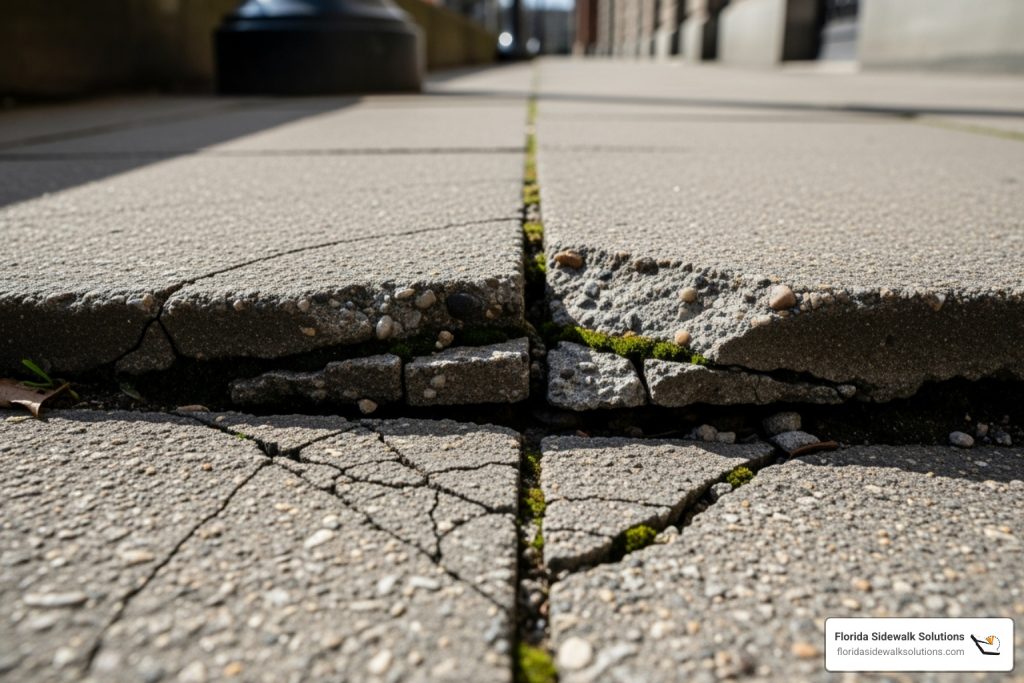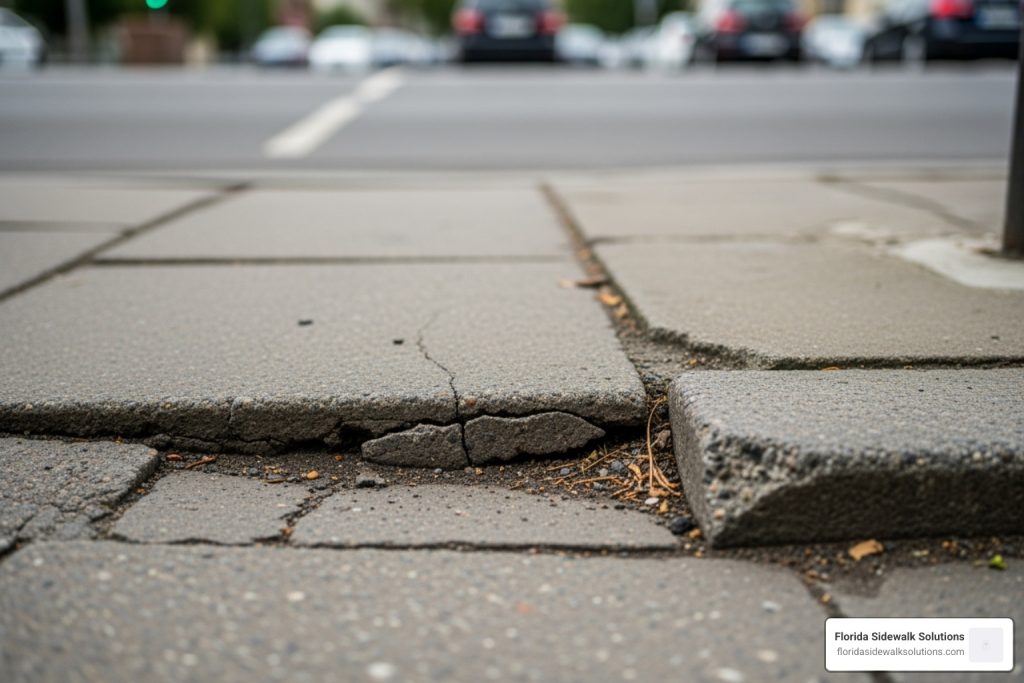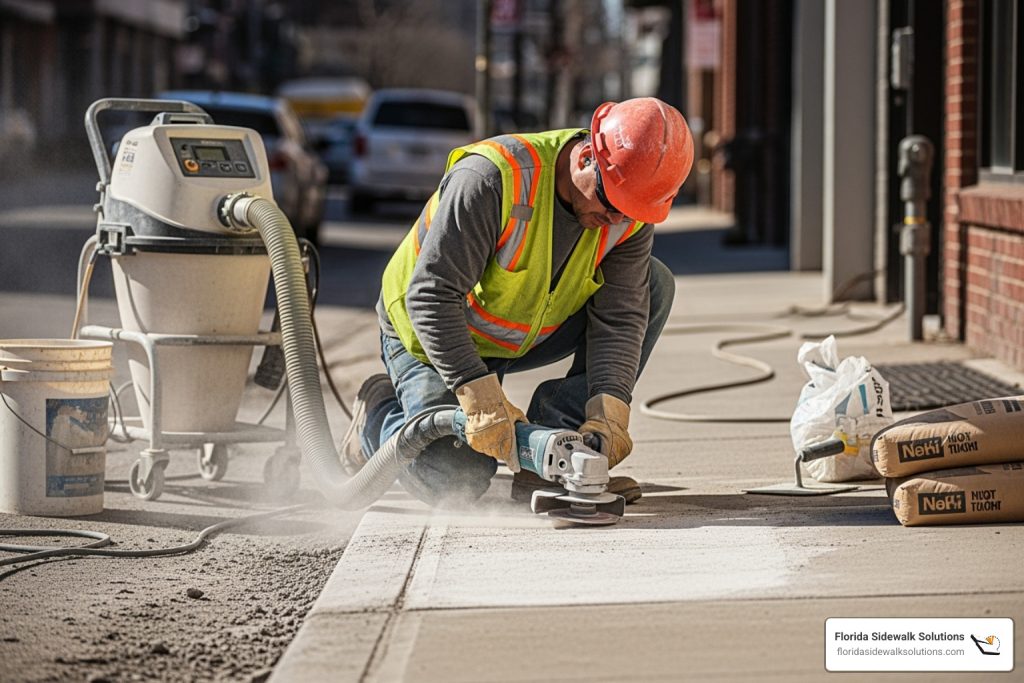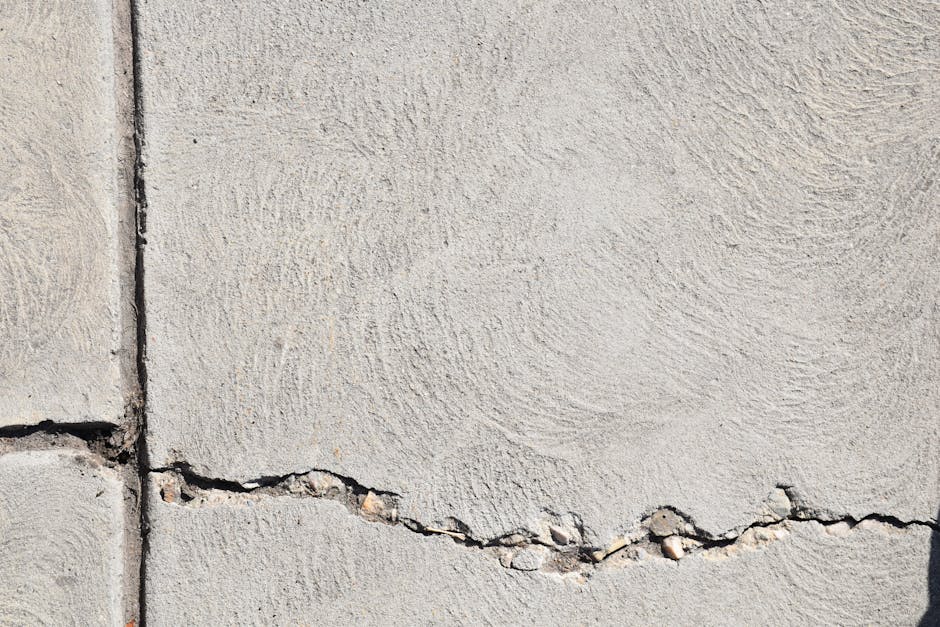Why Addressing Sidewalk Trip Hazards Matters for Your Property
Residential sidewalk repair is essential for homeowners with cracked, uneven, or hazardous walkways. This guide covers what you need to know about finding repair assistance.
Quick Answer: Finding Residential Sidewalk Repair Help
- Identify the hazard: The ADA defines a trip hazard as any level change over 1/4 inch.
- Know your responsibility: Most property owners must maintain adjacent sidewalks.
- Choose the right method: Precision concrete cutting is more cost-effective than grinding or replacement.
- Get professional help: Licensed contractors ensure ADA compliance and handle permits.
- Budget for repairs: Costs vary, but precision cutting can save up to 70% versus replacement.
A cracked or raised sidewalk is more than an eyesore; it’s a major safety hazard. Falls are a leading cause of nonfatal injuries, and uneven sidewalks are a primary culprit. Property owners face legal liability for injuries on their sidewalks, as most municipalities require you to maintain the public walkway next to your property.
Fortunately, modern precision concrete cutting offers a faster, less expensive, and more effective solution than traditional grinding or full replacement. This guide will help you identify hazards, understand your responsibilities, and choose the best repair method.
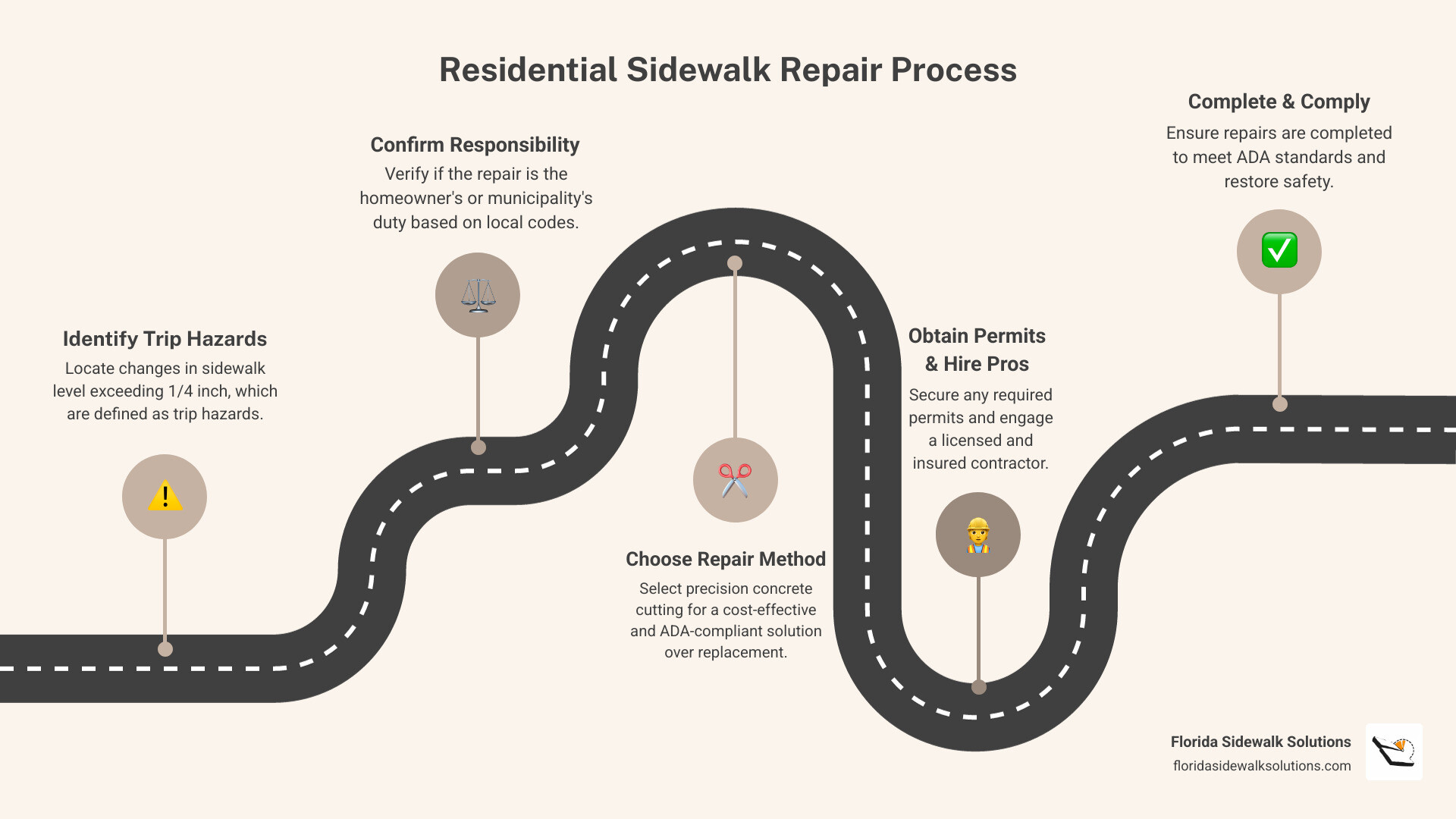
Identifying the Problem: When Does Your Sidewalk Need Repair?

It’s easy to overlook subtle sidewalk damage, but even small issues can create serious hazards. For residential sidewalk repair, the key is knowing when a flaw becomes a liability. According to ADA standards, any vertical change over 1/4 inch is a trip hazard. That small lip is enough to cause a fall.
Common sidewalk trip hazards include:
- Cracks: Any crack creating an uneven surface greater than 1/4 inch needs immediate attention.
- Uneven Surfaces and Sunken Slabs: This is common in Florida, where one concrete slab sinks or rises, creating a dangerous edge.
- Raised Sections: Often caused by tree roots pushing upward, creating significant vertical displacement.
- Spalling: The concrete surface flakes or chips away. If a depression of 1/2 inch or deeper covers more than half a panel, it needs repair.
- Holes or Depressions: Any hole over three inches across and half an inch deep is a hazard, especially for those with mobility aids.
- Missing Sections: Any missing concrete, from a small chip to a full panel, requires immediate repair.
What causes this damage in Florida?
- Tree Roots: A primary cause, as roots exert tremendous pressure from below, heaving and cracking sidewalks.
- Soil Settlement: The ground can settle unevenly, especially if it was poorly compacted or disturbed by utility work.
- Water Damage: Poor drainage erodes the soil supporting the concrete. In Florida’s rainy climate, this is a major concern.
- Wear and Tear: Years of foot traffic and sun exposure take their toll. Heavy impacts can also cause immediate damage.
Catching these problems early is crucial. Regular inspections help you spot issues before they become serious safety hazards or require extensive, costly repairs. You can view examples of different sidewalk defects to learn what to look for. Knowing that even small changes can create big problems is the first step toward maintaining a safe, ADA-compliant walkway.
Understanding Your Responsibility: Homeowner vs. Municipality
A common question from Florida homeowners is, “Am I responsible for the public sidewalk in front of my house?” The answer is almost always yes. While the walkway is in the public right-of-way, the responsibility for its maintenance and repair typically falls on the adjacent property owner.
This principle is common nationwide and is codified in local ordinances, similar to the State Highway Code (5611) in other regions. The basic rule is that property owners maintain the sidewalks adjacent to their property. This includes not only basic upkeep like clearing debris but also crucial residential sidewalk repair. When your sidewalk cracks, becomes uneven, or develops a trip hazard, you are responsible for fixing it.
Many Florida cities, from Fort Lauderdale to Fort Myers, conduct sidewalk inspections. If they find a hazard, you may receive a Notice to Repair (NTR), which is a legal requirement with a deadline. Ignoring it can lead to the city making the repair and billing you, sometimes with added fees or a lien on your property.
If you’re in an HOA, check your community’s rules, as they may have additional requirements or procedures. Some HOAs manage repairs, while others enforce homeowner responsibility.
Understanding your property owner responsibility is key to avoiding legal and financial trouble. It protects you from homeowner liability in case of an accident. Fortunately, modern trip hazard removal methods make it more affordable than ever to stay compliant.
The Dangers of Damaged Sidewalks: Liability and Safety Risks
A damaged sidewalk is a serious safety hazard. For Florida homeowners, understanding the risks is a key part of considering residential sidewalk repair.
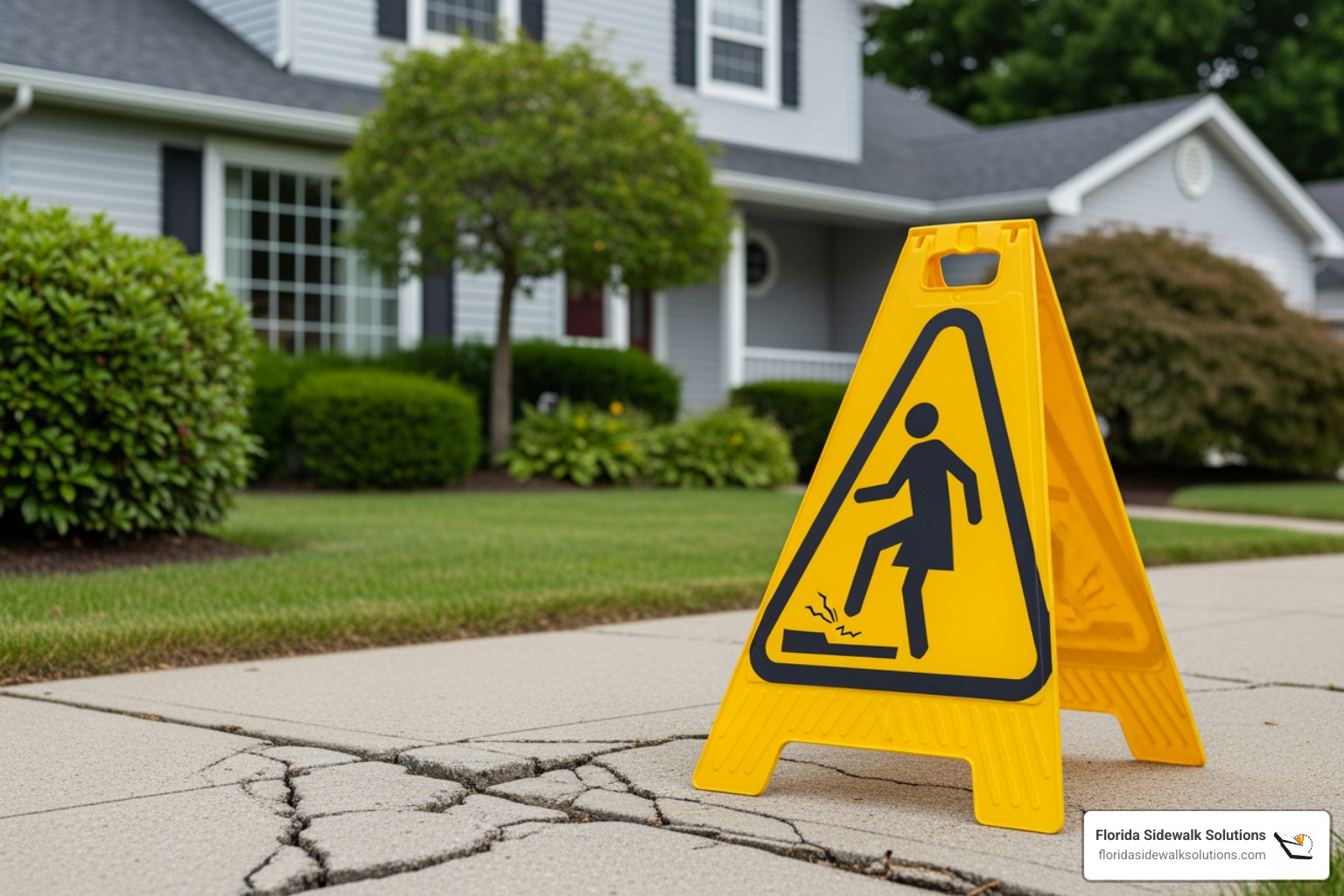
The primary danger is trip-and-fall accidents. Even a small crack or raised slab can cause severe injuries, such as broken bones or head trauma. According to the National Safety Council, falls account for 32% of all nonfatal injuries.
As the property owner, you are legally obligated to maintain a safe sidewalk. This protects you from significant legal liability. If someone is injured on your sidewalk, you could face a personal injury lawsuit, leading to staggering legal fees and higher homeowner insurance premiums. Since Florida municipalities place maintenance responsibility on homeowners, you can be held liable.
ADA compliance is also critical. The ADA defines any vertical change over 1/4 inch as a trip hazard. A non-compliant sidewalk is an accessibility barrier and increases your liability. Proper repair ensures pedestrian safety for everyone. For HOAs and property managers, safe sidewalks can also lead to better HUD NSPIRE scores, improving a property’s reputation.
Fixing your sidewalk is about protecting people from injury and yourself from financial and legal trouble. Effective residential sidewalk repair is a smart investment in safety and peace of mind.
Your Guide to Residential Sidewalk Trip Hazard Repair Solutions and Costs
When facing a sidewalk trip hazard, you need an effective, affordable, and minimally disruptive solution. Modern residential sidewalk repair offers Florida homeowners smart alternatives to the traditional “rip and replace” approach. The most effective sidewalk repair options eliminate vertical displacement while preserving existing concrete.
Cost factors vary by method. Full replacement is expensive, often running $8-$20 per square foot plus demolition, disposal, and labor. In contrast, modern trip hazard removal techniques that preserve your concrete can save up to 70%. A quality repair should be durable, meet ADA standards (eliminating any vertical change over 1/4 inch), and blend with your existing sidewalk.
Why Choose the Florida Sidewalk Solutions Method: Precision Concrete Cutting
At Florida Sidewalk Solutions, we believe there’s a smarter way to fix trip hazards. Our precision concrete cutting method uses patented technology for trip hazard removal. We precisely shave down the raised portion of a slab to create a smooth, safe transition without destroying the surrounding concrete.
Key benefits of our method include:
- Clean Finish: Our cuts create a smooth, ADA-compliant slope that meets the strict 1/4-inch vertical change requirement, ensuring true safety and curb appeal.
- Cost-Effective: By avoiding demolition, disposal, and new materials, our method can save you thousands compared to replacement. You pay for a targeted, effective fix.
- Less Disruptive: Most repairs are completed in less than a day, with no heavy equipment or extended construction zones on your property.
- Long-Term Solution: We create a stable, level surface that extends the life of your existing sidewalk. This technology is a significant advantage over outdated methods like grinders or scabblers.
Why Not Use Outdated Methods?
Traditional repair methods have significant drawbacks for homeowners.
- Conventional Grinders and Scabblers: These tools chip and grind the surface, often leaving a rough, pitted finish that looks poor and may not fully meet ADA standards. The repair stands out and can even create a new, smaller hazard.
- Full Removal and Replacement: This option has higher costs and causes more disruption. It involves jackhammers, concrete trucks, and days of curing time. Furthermore, replacement doesn’t address underlying issues like soil settlement, meaning the problem could reappear in a few years.
When evaluating residential sidewalk repair options, the smartest solution is often the one that precisely fixes what’s broken without the cost and hassle of replacing what isn’t.
The Repair Process: From Permits to Project Completion
Understanding the repair process makes fixing your sidewalk straightforward, whether you’ve received a Notice to Repair or identified a hazard yourself. Here’s a guide to navigating the process from paperwork to completion.
Do You Need a Permit for Residential Sidewalk Repair?
Most likely, yes. Any residential sidewalk repair that alters the sidewalk’s surface level, including precision concrete cutting, typically requires a permit. Florida communities like Davie, Fort Lauderdale, and Miami have regulations to ensure repairs meet safety and ADA standards.
While filling a tiny crack may not need approval, most major repairs do. Permit costs are usually modest ($50-$200) and are a worthwhile expense to avoid fines or having to redo the work. The process generally involves an application to your local public works department. Check your city’s website or office for specific details, similar to the Sidewalk Repair Permit processes in other municipalities. Don’t skip this step.
How to Hire a Professional Sidewalk Trip Hazard Contractor
Finding the right professional is crucial for a lasting repair. Follow these steps to hire a qualified contractor:
- Look for specialists: Choose companies that focus on trip hazard removal, like Florida Sidewalk Solutions. They have the specialized knowledge and technology for ADA-compliant repairs that general contractors may lack.
- Get multiple quotes: Contact at least three professionals for quotes on ADA-compliant trip hazard removal. Be wary of anyone who immediately suggests full replacement for a simple raised slab.
- Verify licenses and insurance: Ensure any contractor is properly licensed and insured in Florida. This protects you from liability during the project.
- Check references and past work: Ask for references and a portfolio of similar projects. Before-and-after photos can show you the quality of their work.
- Ask about their method: A knowledgeable contractor should explain why they recommend a specific method, such as precision cutting over grinding or replacement. At Florida Sidewalk Solutions, we can detail why our cutting method provides superior, cost-effective results.
- Get a detailed written estimate: The estimate should break down all costs, including labor, materials, and permit fees, along with a clear timeline.
- Inquire about work guarantees: A reputable contractor will offer a warranty, showing confidence in their work.
By asking the right questions, you can find a professional who delivers safe, durable, and ADA-compliant results.
Proactive Care: Preventing Future Sidewalk Trip Hazards
After investing in residential sidewalk repair, preventative care can extend the life of your sidewalks and stop trip hazards from returning.
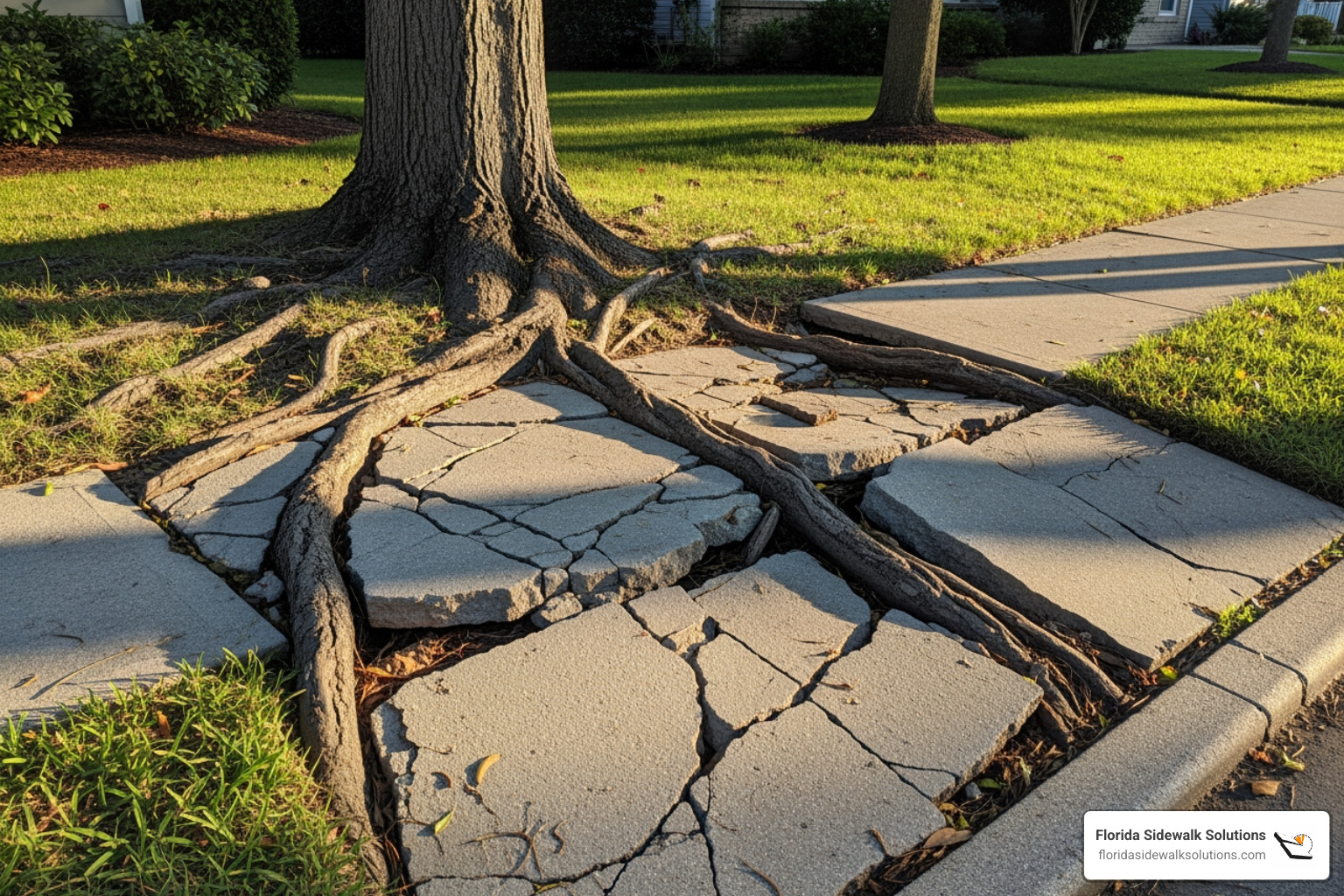
- Manage Tree Roots: Tree roots are a primary cause of sidewalk damage in Florida. If you have trees near your sidewalk, consider installing root barriers or consult an arborist. When planting new trees, choose species with less aggressive root systems. Some municipalities offer resources like this guide on reducing tree and sidewalk conflicts. Address root uplift early.
- Ensure Proper Drainage: Water pooling near or under your sidewalk erodes the soil base, causing settlement and cracks. Ensure downspouts direct water away from walkways and that the ground slopes away from the concrete.
- Conduct Regular Inspections: Walk your sidewalks every few months to look for early warning signs like small cracks or slight unevenness. Catching issues early allows for less expensive repairs.
- Seal Your Concrete: Applying a quality sealant every few years protects against moisture penetration and wear from Florida’s sun and rain.
- Avoid Heavy Loads: Sidewalks are for pedestrians. Keep cars and heavy equipment off them to prevent cracks and structural damage.
- Make Timely Repairs: Don’t postpone fixing minor issues. A small crack is easier and cheaper to repair now than a major hazard later.
Proactive care will keep your sidewalks safe, attractive, and ADA-compliant for years.
Conclusion
Your sidewalk is a key part of your property’s safety and value. Understanding trip hazards, your responsibilities, and the best repair solutions puts you in control of your residential sidewalk repair needs. You now know how to spot warning signs, understand your legal obligations, and avoid the high costs and poor results of outdated repair methods.
Florida Sidewalk Solutions offers a precise, cost-effective, and ADA-compliant solution. Our patented precision concrete cutting technology creates smooth, level surfaces without the disruption and expense of full replacement, saving you up to 70%. We don’t grind your concrete or tear it out; we provide a targeted fix that restores safety and appearance.
For a smarter approach to trip hazard removal in Davie, Fort Lauderdale, Coral Springs, Boca Raton, West Palm Beach, Miami, or Fort Myers, trust our advanced technology.

